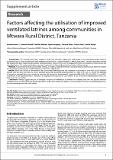| dc.contributor.author | Kema, Koronel | |
| dc.contributor.author | Semal, Innocent | |
| dc.contributor.author | Mkuwa, Serafina | |
| dc.contributor.author | Kagonji, Ignatio | |
| dc.contributor.author | Temu, Florence | |
| dc.contributor.author | Ilako, Festus | |
| dc.contributor.author | Mkuye, Martin | |
| dc.date.accessioned | 2021-08-16T19:57:24Z | |
| dc.date.available | 2021-08-16T19:57:24Z | |
| dc.date.issued | 12/25/2012 | |
| dc.identifier.citation | Koronel Kema, Innocent Semali, Serafina Mkuwa, Ignatio Kagonji, Florence Temu, Festus Ilako, Martin Mkuye. Factors affecting the utilisation of improved ventilated latrines among communities in Mtwara Rural District, Tanzania. Pan Afr Med J. 2012;13(Supp 1):4 | en_US |
| dc.identifier.issn | 1937-8688 | |
| dc.identifier.uri | http://dspace.amref.org/handle/123456789/55 | |
| dc.description | his article is published as part of the supplement “AMREF´s evidence in advancing the health of women and children”
Supplement sponsored by AMREF - African Medical and Research Foundation
© Koronel Kema et al. The Pan African Medical Journal - ISSN 1937-8688. This is an Open Access article distributed under the terms of the Creative Commons Attribution License (http://creativecommons.org/licenses/by/2.0), which permits unrestricted use, distribution, and reproduction in any medium, provided the original work is
properly cited. | en_US |
| dc.description.abstract | Introduction: The Tanzania government, working in partnership with other stakeholders implemented a community-based project aimed at increasing access to clean and safe water basic sanitation and promotion of personal hygiene in Mtwara Rural District. Mid-term evaluation revealed that progress had been made towards improved ventilated latrines; however, there was no adequate information on utilisation of these latrines and associated factors. This study was therefore conducted to establish the factors influencing the utilisation of these latrines.
Methods: A cross-sectional study was conducted among 375 randomly selected households using a pre-tested questionnaire to determine whether the households owned improved ventilated latrines and how they utilised them.
Resuls: About half (50.5%) of the households had an improved ventilated latrine and households with earnings of more than 50,000 Tanzanian Shillings were two times more likely to own an improved latrine than those that earned less (AOR 2.1, 95% CI=1.1-4.0, p= 0.034). The likelihood of owning an improved latrine was reduced by more than 60 percent for female-headed households (AOR=0.38; 95% CI=0.20-0.71; p=0.002). Furthermore, it was established that all members of a household were more likely to use a latrine if it was an improved ventilated latrine (AOR=2.4; 95% CI=1.1-5.1; p= 0.024).
Conclusion: Findings suggest adoption of strategies to improve the wellbeing of households and deploying those who had acquired improved ventilated latrines as resource persons to help train others. Furthermore, efforts are needed to increase access to soft loans for disadvantaged members and increasing community participation. | en_US |
| dc.description.sponsorship | European Union | en_US |
| dc.language.iso | en | en_US |
| dc.publisher | Pan African Medical Journal | en_US |
| dc.subject | Utilization | |
| dc.subject | Ventilated Improved Pit latrines | |
| dc.subject | Water and sanitation | |
| dc.subject | Tanzania | en_US |
| dc.title | Factors Affecting the Utilisation of Improved Ventilated Latrines Among Communities in Mtwara Rural District, Tanzania | en_US |
| dc.type | Article, Journal | en_US |

